Abstract
Gene flow among 18 widely separated populations of the starfishLinckia laevigata was investigated using allozyme electrophoresis at seven polymorphic enzyme loci. Little genetic differentiation was observed among East Indian-West Pacific populations separated by thousands of kilometres. Gene flow was estimated to be of the same order of magnitude as that found in the highly connected Great Barrier Reef region. The absence of genetic structure over such a broad geographic range is consistent with any of three conclusions: (1) there is extensive dispersal among widely separated populations across the range examined, (2) there has been a rapid expansion of the East Indian-West Pacific populations in the recent past, or (3) the loci surveyed are under the influence of balancing selection. The first two conclusions are not totally exclusive, since a recent expansion over several thousand generations would also require rapid dispersal at some stage, although present-day levels of dispersal need not be of the same order. With the available data, it is not possible to distinguish which of these mechanisms is the most likely. The most parsimonious conclusion is that extremely low levels of population differentiation are consistent with the existence of a large, homogeneous, panmictic population, with extensive dispersal occurring throughout the East Indian-West Pacific.
Similar content being viewed by others
References
Avise JC, Ball RM, Arnold J (1988). Current versus historical population sizes in vertebrate species with high gene flow: a comparison based on mitochondrial DNA lineages and inbreeding theory for neutral mutations. Molec Biol Evolut 5: 331–344
Avise JC, Reeb CA, Saunders NC (1987) Geographic population structure and species differences in mitochondrial DNA of mouthbrooding marine catfishes (Ariidae) and demersal spawning toadfishes (Batrachoididae). Evolution 41: 991–1002
Baker CS, Slade RW, Bannister JL, Abernathy RB, Weinrich MT, Lien J, Urban J, Corkeron P, Calabokidis J, Vasquez O, Palumbi SR (1994) Hierarchical structure of mitochondrial DNA gene flow among humpback whales,Megaptera novaeangliae, world-wide. Molec Ecol 3: 313–327
Bell LJ, Moyer JT, Numachi K (1982) Morphological and genetic variation in Japanese populations of the anemonefishAmphiprion clarkii. Mar Biol 72: 99–108
Benzie JAH, Black KP, Moran PJ, Dixon P (1994) Small-scale dispersion of eggs and sperm of the crown-of-thorns starfish (Acanthaster planci) in a shallow coral reef habitat. Biol Bull mar biol Lab, Woods Hole 186: 153–167
Benzie JAH, Frusher S, Ballment E (1992) Geographical variation in allozyme frequencies of populations ofPenaeus monodon (Crustacea: Decapoda) in Australia. Aust J mar Freshwat Res 43: 715–725
Benzie JAH, Stoddart JA (1992) Genetic structure of crown-of-thorns starfish (Acanthaster planci) in Australia. Mar Biol 112: 631–639
Black KP, Gay SL, Andrews JC (1990) Residence times of neutrally buoyant matter such as larvae, sewage or nutrients on coral reefs. Coral Reefs 9: 105–114
Black K(P), Moran P, Burrage D, De'ath G (1995) Association of low-frequency currents at crown-of-thorns starfish outbreaks. Mar Ecol Prog Ser 125: 185–194
Bowen BW, Meylan AB, Ross JP, Limpus CJ, Balaz GH, Avise JC (1992) Global population structure and natural history of the green turtle (Chelonia mydas) in terms of matriarchal phylogeny. Evolution 46: 865–881
Burnett WJ, Benzie JAH, Beardmore JS, Ryland JS (1994) High genetic variability and patchiness in a common Great Barrier Reef zoanthid (Palythoa caesia). Mar Biol 121: 153–160
Buroker NE (1983) Population genetics of the American oysterCrassostrea virginica along the Atlantic coast and the Gulf of Mexico. Mar Biol 75: 99–112
Guo SW, Thompson EA (1992) Performing the exact test of Hardy-Weinberg proportion for multiple alleles. Biometrics 48: 361–372
Hilbish TJ, Koehn RK (1985) Dominance in physiological phenotypes and fitness at an enzyme locus. Science, NY 229: 52–54
Holm S (1979) A simple sequentially rejective multiple test procedure. Scand J Statist 6: 65–70
Johnson MS, Clarke B, Murray J (1988) Discrepancies in the estimation of gene flow inPartula. Genetics, Austin, Tex 120: 233–238
Johnson MS, Joll LM (1993) Genetic subdivision of the pearl oysterPinctada maxima (Jameson, 1901) (Mollusca: Pteriidae) in northern Australia. Aust J mar Freshwat Res 44: 519–534
Karl SA, JC Avise (1992) Balancing selection at allozyme loci in oysters: implications from nuclear RFLPs. Science, NY 256: 100–102
Klumpp DW, Pulfrich A (1989) Trophic significance of herbivorous macroinvertebrates on the central Great Barrier Reef. Coral Reefs 8: 135–144
Koehn RK, Milkman R, Mitton JB (1976). Population genetics of marine pelecypods. IV. Selection, migration and genetic differentiation in the blue musselMytilus edulis. Evolution 30: 2–32
Lavery S, Shaklee JB (1989) Population genetics of two tropical sharks,Carcharhinus tilstoni andC. sorrah, in northern Australia. Aust J mar Freswat Res 40: 541–557
Lewis RI, Thorpe JP (1994) Temporal stability of gene frequencies within genetically heterogeneous populations of the queen scallopAequipecten (Chlamys) opercularis. Mar Biol 121: 117–126
Miller RG (1966) Simultaneous statistical inference. McGraw-Hill, New York
Nei M (1978) Estimation of average heterozygosity and genetic distance from a small number of individuals. Genetics, Austin, Tex 89: 583–590
Nei M, Maruyama T, Chakraborty R (1975) The bottleneck effect and genetic variability in populations Evolution 29: 1–10
Nishida M, Lucas JS (1988) Genetic differences between geographic populations of the crown-of-thorns starfish throughout the Pacific region. Mar Biol 98: 359–368
Palumbi SR (1992) Marine speciation on a small planet. Trends Ecol Evolut 7: 114–118
Palumbi SR, Wilson AC (1990) Mitochondrial DNA diversity in the sea urchinsStrongylocentrotus purpuratus and S. droebachiensis. Evolution 44: 403–415
Paulay G (1990) Late Cenozoic sea level fluctuations and the diversity and species composition of insular shallow water marine faunas. In: Dudley EC (ed) The unity of evolutionary biology. Dioscorides Press, Portland, Oregon, pp 184–193 (Proc 4th int Congr syst evolut Biol)
Raymond M, Rousset F (1995) GENEPOP (Version 1.2). Population genetics software for exact tests and ecumenicism. J Hered 86: 248–249
Rice WR (1989) Analysing tables of statistical tests. Evolution 43: 223–225
Russo CAM, Solé-Cava AM, Thorpe JP (1994) Population structure and genetic variation in two tropical sea anemones (Cnidaria, Actinidae) with different reproductive strategies. Mar Biol 119: 267–276
Saunders NC, Kessler LG, Avise JC (1986) Genetic variation and geographic differentiation in mitochondrial DNA of the horseshoe crab,Limulus polyphemus. Genetics, Austin, Tex 112: 613–627
Shulman MJ, Bermingham E (1995) Early life histories, ocean currents, and the population genetics of Caribbean reef fishes. Evolution 49: 897–910
Silberman JD, Sarver SK, Walsh PJ (1994) Mitochondrial DNA variation and population structure in the spiny lobsterPanulirus argus. Mar Biol 120: 601–608
Slatkin M (1985) Gene flow in natural populations. A Rev Ecol Syst 16: 393–430
Slatkin M (1993) Isolation by distance in equilibrium and nonequilibrium populations. Evolution 47: 264–279
Stickle WB, Foltz DW, Katoh M, Nguyen HL (1992) Genetic structure and mode of reproduction in five species of sea stars (Echinodermata: Asteroidea) from the Alaskan coast. Can J Zool 70: 1723–1728
Swofford DL, Selander RB (1981) BIOSYS-1: a FORTRAN program for the comprehensive analysis of electrophoretic data in population genetics and systematics. J Hered 72: 281–283
Utter FM, Waples RS, Teel DJ (1992) Genetic isolation of previously indistinguishable chinook salmon populations of the Snake and Kalmouth Rivers: limitations of negative data. Fish Bull US 90: 770–777
Veron JEN (1995) Corals in space and time: the biogeography and evolution of the Scleractinia. University of New South Wales Press, Sydney
Waples RS (1987) A multispecies approach to the analysis of gene flow in marine shorefishes. Evolution 41: 385–400
Weir BS (1990) Genetic data analysis. Sinauer Associates, Inc., Sunderland, Mass
Weir BS, Cockerham CC (1984) Estimating F-statistics for the analysis of population structure. Evolution 38: 1358–1370
Williams ST, Benzie JAH (1993) Genetic consequences of long larval life in the starfish,Linckia laevigata (Echinodermata: Asteroidea) on the Great Barrier Reef. Mar Biol 117: 71–77
Workman PL, Niswander DJ (1970) Population studies on south western Indian tribes. II. Local genetic differentiation in the Papago. Am J hum Genet 22: 24–49
Yamaguchi M (1977) Population structure, spawning, and growth of the coral reef asteroidLinckia laevigata (Linnaeus). Pacif Sci 31: 13–30
Yates F (1934) Contingency tables involving small numbers and theX 2 test. Jl R statist Soc (Suppl) 1: 217–235
Yeatman J, Benzie JAH (1994) Genetic structure and distribution ofPhotololigo species in Australia. Mar Biol 118: 79–87
Author information
Authors and Affiliations
Additional information
Communicated by G. F. Humphrey, Sydney
Rights and permissions
About this article
Cite this article
Williams, S.T., Benzie, J.A.H. Genetic uniformity of widely separated populations of the coral reef starfishLinckia laevigata from the East Indian and West Pacific Oceans, revealed by allozyme electrophoresis. Mar. Biol. 126, 99–107 (1996). https://doi.org/10.1007/BF00571381
Received:
Accepted:
Issue Date:
DOI: https://doi.org/10.1007/BF00571381




